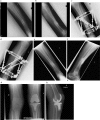Extra-articular deformity correction using Taylor spatial frame prior to total knee arthroplasty
- PMID: 29556929
- PMCID: PMC6249143
- DOI: 10.1007/s11751-018-0310-5
Extra-articular deformity correction using Taylor spatial frame prior to total knee arthroplasty
Abstract
A good long-term outcome following a total knee arthroplasty relies on restoration of the mechanical axis and effective soft tissue balancing of the prosthetic knee. Arthroplasty surgery in patients with secondary osteoarthritis of the knee with an extra-articular tibial deformity is a complex and challenging procedure. The correction of mal-alignment of the mechanical axis is associated with unpredictable result and with higher revision rates. Single-staged deformity correction and replacement surgery often result in the use of constraint implants. We describe our experience with staged correction of deformity using a Taylor Spatial Frame (TSF) followed by total knee arthroplasty in these patients and highlight the advantage of staged approach. The use of TSF fixator for deformity correction prior to a primary total knee arthroplasty has not been described in the literature. We describe three cases of secondary osteoarthritis of the knee associated with multiplanar tibial deformity treated effectively with a total knee arthroplasty following deformity correction and union using a TSF. All patients had an improved Knee Society score and Oxford Knee score postoperatively and were satisfied with their replacement outcome. Staged deformity correction followed by arthroplasty allows the use of standard primary arthroplasty implants with predicable results and flexible aftercare. This approach may also provide significant improvement of patient symptoms following correction of deformity resulting in deferment of the arthroplasty surgery.
Keywords: Osteoarthritis; Staged surgery; Tibial deformity; Tibial non-union; Total knee arthroplasty.
Conflict of interest statement
Conflict of interest
There are no conflicts of interest related to the authors involved in the study.
Ethical consideration
The study does not contain any identifiable patient data. It did not require any ethical committee review.
Informed consent
Consent from the patients involved was still obtained and documentation made in their case notes.
Figures



References
-
- Wolff AM, Hungerford DS, Pepe CL. The effect of extraarticular varus and valgus deformity on total knee arthroplasty. Clin Orthop Relat Res. 1991;271:35–51. - PubMed
-
- Catonne YRJ, Delattre O. TKR in patients with severe extra-articular deformity—a review of 30 cases. J Bone Joint Surg Br. 2001;83(Suppl II):169.
LinkOut - more resources
Full Text Sources
Other Literature Sources
Research Materials

